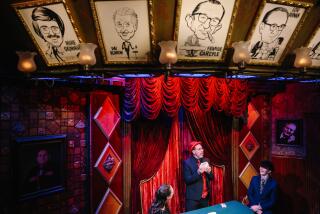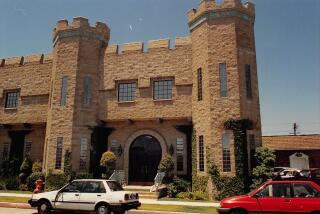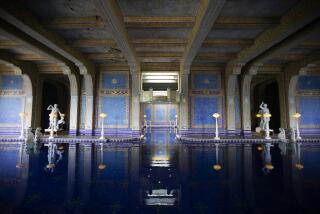14 Scottish Castles in 4 Days : Exploring the Stylish Structures and Verdant Highlands Fulfills a Childhood Dream
- Share via
EDINBURGH, Scotland — Swaying with the motion of the subway train as it left London, I looked above my fellow passengers’ heads and saw the advertisement picturing peaceful pasture land, a castle and lines that read, “Experience the hush of Scotland, nature’s answer to the Picadilly Circus Line.” I smiled with the anticipation of soon being--together with my daughter, Becca, and son-in-law, Glenn--exactly where that ad was suggesting.
With three stuffed dufflebags between us, we had joined all the others on the Picadilly Circus Line of the London subway early that cold, rainy May morning. We were on our way to King’s Cross Station, where we would board the BritRail train to Edinburgh, to begin living one of my fantasies--searching for castles in the Scottish Highlands and visiting famed Loch Ness.
From childhood, I had been drawn to castles. Then, about 10 years ago, I traveled by boat down the Rhine between Mainz and Koblenz, Germany, where the castle ruins of ancient legend stood. I wanted, in the worst way, to be able to walk into one, to explore the ruins and tread on the fairy-tale ground of my childhood dreams.
So years later, when my son-in-law asked me what I would most like to do while in Great Britain, without hesitation I said, “Search for castles to explore and see the Scottish Highlands.” This coincided nicely with Glenn’s wish to look for the monster in Loch Ness. He arranged to pick up a rental car at a hotel in Edinburgh and, with only a map in hand for general direction, we were off.
After 4 1/2 hours of watching rolling green pasture land, quaint villages, blotches of bright yellow rape seed, sheep and cattle, our multi-coach train screeched into Edinburgh (pronounced Edin-burra) Station. We taxied to the hotel, where we picked up our rental car and, as we loaded up back of the hotel, we spied--what else?--Edinburgh Castle, perched on a hill of rock right in the middle of the city.
Since we weren’t staying at the hotel and it was already 4 in the afternoon, we decided to leave that castle for last, and headed northeast out of town. We had decided in advance to travel the back roads, and stay in bed and breakfasts for added adventure and cost savings.
We didn’t see any castles that afternoon, but did notice that we seemed to be the only car on the road, undoubtedly due to it being early in the season. Dusk comes about 9 p.m. in Scotland’s springtime, so we let our stomachs be our guide as to when we started looking for the night’s lodging.
Our first night we pulled up to the Cambo Arms Inn, an 18th-Century coaching inn, now a delightful B&B; near St. Andrews. The price was reasonable, the atmosphere warm and friendly, the ambience rustic and the food delicious. For an extra fee, one could have dinner at the inn, a favorite with the locals. We did, and, over dinner, some of the regulars showed us what back roads to take.
The next morning we were introduced to the accepted Scottish breakfast of two eggs cooked to our pleasure, homemade sausage, Scottish bacon (like the Canadian variety), hash browns and a fried tomato with toast and jelly, cereals, orange juice and coffee or tea. Fortified, we set off up A93 with high anticipation. Within minutes, our first castle--nestled on a hill of emerald green as if we’d opened the pages of a storybook--came into view. It was Braemar Castle, a single fortified home with no outer buildings.
As we approached, the castle looked every inch a fortress with towering walls, dominating tower, barred windows and gunslits.
Originally, Braemar Castle had four entrances, but today a gate opens only into the central courtyard. We were greeted at the castle door by a distinguished-looking gentleman in Old Scottish garb who guided us through the castle--although we were free to wander about on our own as we wished. He was full of stories and patient explanations to our questions.
The castle was built in 1628 by the Earl of Mar as a hunting lodge in the forests of Deeside (along the River Dee) and a fortress against the rising power of the family known as the Farquharsons of Invercauld. Sixty years later, the castle was burned out by John Farquharson of Inverey, known as the Black Colonel--a romantic figure who, according to Deeside legend, always summoned his servant by gunshot and frequently gave the British Dragoons the slip.
The castle remained a burned shell until it was restored for occupation as a garrison post in 1748. By 1807, times were finally peaceful and the castle was returned to the Farquharsons of Invercauld, who turned it, once again, into a family home--which is what it is today for descendants of the Farquharson family. Queen Victoria was welcomed here when she attended the Braemar Gatherings, still an important yearly event in the Highland calendar.
Parts of each floor, known as apartments, house the resident family, with other parts open to the public. Oddly, while exploring the castle floors, we had no sense of where the family area was located and off-limits to our wanderings.
The dining room and adjoining morning room were on what the British call the first floor (our second floor). On the second floor were the dressing room, bedroom and dining room. Our guide explained that in the 1700s, furnishings were sparse, not lavish as found in some modern royal castles such as Culzean, which we would see several days hence. The occupants, wealthy in contrast to peasants, were more like today’s upper middle class.
On the third and last floor we saw the laird’s (lord’s) bedroom. It had two semi-circular closets that occupied the lowest level of two corner turrets of the main tower. It had an 18th-Century, four-poster canopied bed with hangings of the Farquharson tartan. Hepplewhite chairs were covered with deerskin from the Invercauld estates.
Our first full day had barely begun as we left our first castle behind. But it wasn’t long before Becca exclaimed, “Good grief, there are castles everywhere!” Indeed, it was rare that we didn’t see one or more on the horizon before us, many merely scant ruins. We saw six castles within 50 miles our first day. Glenbachat Castle, Auchindown Castle and Bavanie Castle were three small ruins, easily explored in 15 or 20 minutes. Braemar and Balmoral were lived in, and Kildrummy a more extensive ruin.
As we drove our little car through the green countryside of tiny villages and pastureland, we seemed alone in this magical castle-laden world. We saw few cattle and only the occasional short-legged, stocky and very broad-backed Highland, Fell and Haflinger ponies--used mainly for hunting red deer and for pony trekking.
We got to Balmoral Castle, the summer home of the British royal family, about midmorning. It’s about 10 miles from Braemer Castle, but quite different. Being of royal blood, it’s lush in its grounds and furnishings, surrounded by a beautiful old pine forest, mostly planted by Prince Albert in the 1800s. From the parking area across the river, a broad half-mile carriageway leads directly to the castle. Its foundation stone was laid in 1853 by Queen Victoria, who in her diary commented on the beautiful view seen up the valley of the Dee from the west front windows of the castle. Luxuriant rose gardens on the west were designed to be in full bloom, along with the other formal gardens when the royal family is in residence in August and September. Royal photographs are often taken at the top of the sunken garden. We strolled the wooded grounds, visited the ancient stables and saw a display of royal coaches and boats.
Still marveling at Balmoral, we turned onto A97. It was nearing noon, but we still weren’t hungry as we came upon the ruins of Kildrummy Castle, which in its day of prestigious baronial castles, was considered the mightiest fortress-residence. The first historical mention of Kildrummy was in 1296, when Edward I of England visited its owner, Donald, Earl of Mar.
The castle was defended by massive high stone walls called curtains, with several lofty towers, two forming the gatehouse, all housing both domestic and service buildings. Within the castle enclosure, the dominating buildings were the Earl’s great hall, chamber and chapel. The ruins were extraordinary for picture-taking and quickened our imaginations as we explored the rugged foundations, crumbled stone walls, romantic ancient rooms and narrow stone stairways.
After a roadside lunch of cheese, crackers and fruit, we turned onto Highway 941, heading toward Elgin, then Inverness, stopping briefly at the ruins of Auchindown and Bavanie castles. We reached Inverness and Loch Ness by late afternoon, and decided to finish the day with a drive around the lake. Our luck in finding a B&B; was not good that night, so we opted for a hotel in Ft. Augustus at the lower end of Loch Ness.
The next morning was sunny and warm on the banks of Loch Ness, one of four cerulean lakes that form the base of the “Great Glen,” a major geological fault in the British Isles. We visited MacDonald’s Castle, which is still intact and owned by the Scottish Trust, as most Scottish castles now are.
Then we moved on to the west bank of the Loch and Urquhart Castle, its ruins charming and idyllic. The castle is on an emerald green promontory that juts out into the lake, commanding unbroken views of its length. We had read that this site was fortified as far back as the Iron Age (the beginning of the Christian Era). Story has it that a castle first existed around the 7th or 8th Century when St. Columba, an ancient Christian saint, visited Glen Urquhart as part of his mission of conversion. This is also the time when the first mentions of the “Loch Ness Monster” appear in historic writings.
We spent an hour at this castle ruin, climbing into its tower, imagining a lady watching for her laird to return by boat, or guards watching for enemies approaching in the night by water.
As with all 14 castles and ruins we visited during our four days, excepting Balmoral Castle, Urquhart changed ownership many times as Scottish lords fought for control of land and castles. It was laid waste and reconstructed several times from the 15th through the 17th centuries, and by 1645 was no longer used as a residence; even its military value was in decline. Plundered by the country folk, in February of 1715 it was recorded that the “Castell of Urquhart is blowen down with the last storms of wind.” The castle was handed over to the government of Scotland in 1912 by its then-owners, the Grant family, and extensive operations to make the ruins secure were completed in 1942. But on this day, its yellow-stone remains--backdropped against emerald grass and indigo water--spurred our imaginations.
After exploring the banks of Loch Ness and visiting the Loch Ness Monster Center in Ft. Augustus, we followed Highway 828, paused briefly at an unnamed castle ruin, then set out to find our B&B; for the night. It was after 5 p.m. when we discovered Dunstaffnage Castle near Oban--its ticket office closed and nothing to keep us out of this foreboding, walled castle home. It was roofless, with scaffolding by one of the walls. But inside, we ducked through doorways, climbed narrow stone stairs and wandered through second-floor rooms, then went down to what appeared to be dungeon cells and up to a great hall. We could see where there might have been a bucket lowered for water, and an old stream out side that would have flowed under an ancient tree near the wall.
Leaving Dunstaffnage, we found our B&B; in Ardrishaig. Eighteenth-Century Fascadale House, on Highway A23, could only be described as elegant, with four guest rooms inside the main house, a lounge and dining room all richly decorated and furnished. Down the drive were several rental cottages for extended stays.
The next morning we bade farewell to our Fascadale hosts and headed out toward the ferry at Dunoon, where we would cross over to Grourock and head for the town of Ayr, Robert Burns country. We saw Inverary Castle about 30 miles out of Andrishaig, stopped for a brief look and moved on.
At this point in our travels, we were beginning to feel a new understanding and appreciation for the struggles and fears of the people who once lived, loved, fought and died in this land of now-romantic old castles. In Ayr, we had been told about a magnificent castle about 10 miles down the highway. It became our next stop. Culzean (pronounced Cul-EEN) Castle dates from medieval times. During World War II, Gen. Eisenhower occasionally stayed at the castle in what is known as the National Guest Flat, returning once as President of the United States. The castle furnishings we saw were elegant, more like I had expected castle furnishings to be. Probably the most elegant and beautiful part of the castle to me was the curved staircase in an enclosed courtyard, with light streaming down from the high ceiling above.
It was late afternoon when we left and headed for the town of Stirling, where we searched for our last B&B.; We chose Craig Lea, a majestic-looking old house on a busy street.
Our four days of castle trekking were coming to an end (we had traveled about 500 miles) with two castles yet to see: Stirling Castle and Edinburgh Castle, both closely identified from the 12th Century with the history of Scotland. During the Middle Ages, the capital of the kingdom was wherever the king happened to be in residence, and both Stirling and Edinburgh have many of the features of a medieval capital. We noted that while Stirling Castle was not as large as Edinburgh, both speak of the king’s residence as the “palace,” with a “chapel royal,” several courtyards, a great hall and a college. Edinburgh included a hospital and today holds the Scottish Crown Jewels, the emotionally moving Scottish National War Memorial, and is where Mary, Queen of Scots gave birth to James VI in 1566 before moving to the more comfortably spacious home at Holyrood House. Edinburgh Castle covers more area than Stirling Castle, with streets leading to the various buildings, which makes it seem a miniature hamlet of its own.
Both castles are being restored to, as near as possible, their original states. We were told to return in 10 years for a new experience.
GUIDEBOOK
Collecting Scottish Castles
Getting there: From Los Angeles, it’s advisable to fly to Glasgow, picking up a prearranged rental car there (about $130 per week). United, American, Northwest and British Airways currently have round-trip, 14-day advance-purchase, restricted fares of $689 from LAX to Glasgow. Fares are scheduled to rise June 16.
Where to stay: B&Bs;, ranging in price from $20 to $32 per person, are located near villages and in cities. Hotels are fewer, located in larger villages from $40 per person, and in cities for $125-$175.
Cambo Arms Inn B&B;, St. Andrews, Scotland, from U.S. phones, 011-44-334-88226; about $22 per person, children and pets welcome.
Fascadale House B&B;, Tarbert Road by Lockgilphead, Andrishaig, Scotland, tel. 011-44-546-603845; about $30 per person.
Craiglea B&B;, 153 Causewayhead Road, Stirling, Scotland, tel. 011-44-786-473394; about $20 per person.
Castle touring: Most castles and castle ruins are under the protection of the Scottish Trust and generally are open to the public from late April through September. Entrance fees range from about $5 for seniors, students and children under 18 to about $8 for adults. But if you join the Trust anytime along the way for about $14 (students, children under 23), $21 (senior couples), $17 (single seniors), $34 (adult) and $55 (family with children under 18), you’ll get free entrance to the Trust’s more than 300 properties (and refunds of any entrance fees already paid).
For more information: Contact the British Tourist Authority, 350 S. Figueroa St., Suite 450, Los Angeles 90071, (213) 628-3525.
More to Read
Sign up for The Wild
We’ll help you find the best places to hike, bike and run, as well as the perfect silent spots for meditation and yoga.
You may occasionally receive promotional content from the Los Angeles Times.






